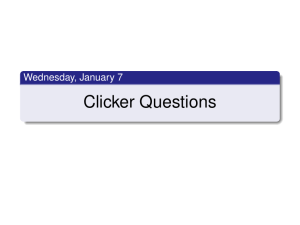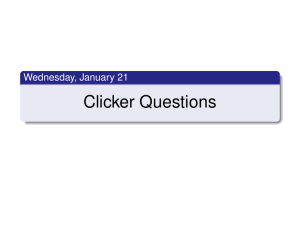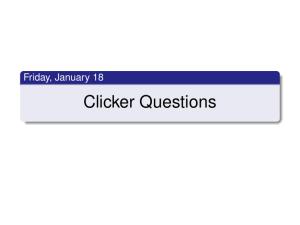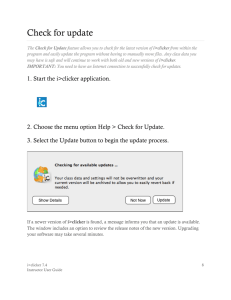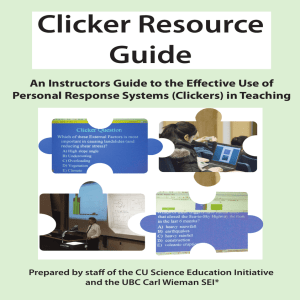Writing Clicker Questions
advertisement
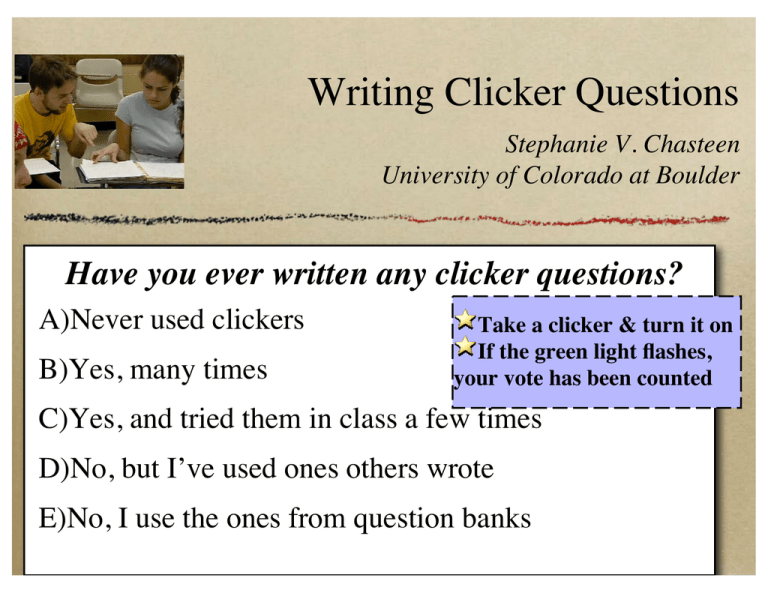
Writing Clicker Questions Stephanie V. Chasteen University of Colorado at Boulder Have you ever written any clicker questions? A)Never used clickers B)Yes, many times Take a clicker & turn it on If the green light flashes, your vote has been counted C)Yes, and tried them in class a few times D)No, but I’ve used ones others wrote E)No, I use the ones from question banks Today’s agenda • • • Discussion of clicker questions Practice writing and revising clicker questions If there’s time… discussion of ways to implement peer discussion and question wrap-up 2 The clicker question cycle 1.Learning goals 2.Ask question 3.Peer discussion 4.Vote 5.Whole class discussion 6.Interpret & use results 3 Quick video break 4 Benefits of clickers “Anonymous” responses Instant feedback to teacher and students Focuses class on a question and forces them to commit to answer Catalyzes discussion Makes your student’s thinking visible Models reasoning and oral presentation 5 I teach... A)Elementary School B)Middle School C)High school D)College or University E)Other/I don’t teach 6 I primarily teach... A)Biology B)Physics C)Math D)Chemistry E)Other 7 Basic use of clickers... •Only for quizzes or testing •Only occasionally or at set times •To check for basic comprehension Better use of clickers... •Frequent and integrated into class •Require or encourage peer discussion •Mix of difficulty •Use results to direct instruction 8 Writing questions video • 2:00-3:10 9 A note on the “wrong” answers • • • Distractors should be tempting And based on common student misunderstandings Don’t forget options like “more than one” or “none of these” What does each answer tell you about student thinking? This is important part of formative assessment. 10 Take a stab… Use the pink handout as a guide • • On your own, take a few minutes to try writing a question for a topic you will be teaching this month. If you have brought a question, either work on revising it, or try a new approach to that same material. 11 I think it’s hardest to… A. Figure out when in class (or why) to use a question B. Decide what type of question to ask C. Write the question itself D. Come up with the “wrong” answers (distractors) E. More than one / something else 12 E.g. Communications You are an editor at the Washington Post, and the Unabomber has demanded that you print his manifesto or he will continue sending mail bombs. As Post editor, which would you value most? • Upholding 1st Amendment independence from gov’t • Increased readership • Maintaining credibility • Possibly help save lives • Informing readers 13 E.g. Chemistry • Demonstration predictions. For example, show that a lightbulb is lit when running a current through a weak acid solution. “Will a 100% acid solution make the light bulb brighter or dimmer?” 14 E.g. Psychology Play students the “Jaws” theme after a break. Is this an example of classical or instrumental conditioning? 15 E.g. Biology Which of the following are alive (can be more than one)? • A seed • A leaf on a tree • A leaf that has just fallen • A tree in spring (no leaves) • A tree in summer (lots of leaves) • A tree in fall (leaves not green) • A tree in winter 16 E.g. Law Application Based on the facts of problem 7 in the textbook, in the lawsuit by the student against Mountain Law School, a court will likely find in favor of the: Student, if the court finds that the terms of the catalogue are complete, definite, and certain Student, since catalogues are usually considered ads, and ads are always offers Law school, since catalogues can never include all the necessary terms to be deemed definite and complete offers Law school, since the student could not have been expected to be taught all the terms in the catalogue 17 • • • • • • One best E.g., Medicine answer RR is a 22 year old Mexican american newly diagnosed with type I diabetes. He weighs 68 kg. He has no insurance and speaks limited english. What is the best insulin regimen to start him on? Gliargine 15 units at bedtime NPH 30 units twice daily Mixed insulin 70/30, 20 units in the morning and 10 units at bedtime Glargine 15 units at bedtime and lispro 5 units with meals Levemir 15 units twice daily 18 You’re on a cart, at rest, throwing E.g.initially Physics balls at a partition that is rigidly mounted on the front ofBALL the cart. If the balls bounce BOUNCE Suppose on a cart, initially rest o straight back, as inyou theare figure, then is theat cart balls at a partition that is rigidly mounted on put in motion? bounce straight back, as shown in the figure A.Yes, left 1. Yes, left B.Yes, right 2. Yes, right C.No 3 . No A. Donʼt know D.Don’t know 19 E.g. Environmental Science Students watch section of The Day After Tomorrow. Then are asked Global warming could lead to the shutdown of the North Atlantic’s ocean circulation pattern causing global cooling • Strongly agree • Moderately agree • Moderately disagree • Strongly disagree 20 Modes of clicker use 1) quiz on the reading or homework 6)transfer/implication 2) require recall of lecture point 7) relate different representations 3) elicit/reveal prior ideas 8) Help visualization skills 4) require prediction of demo, expt, sim. 5) test conceptual understanding 9) do a calculation 10) survey students 11) Enter responses from timed test 21 What makes a “good” question? 22 Work with a buddy Example questions Use the “what makes a good clicker question” sheet (pink) Rate some questions on blue sheet 1=bad, 2=OK, 3=good. ARE YOU DONE? A)Still working B)Nearly there C)Done! 23 Work with a buddy Writing questions Now, take the question you started before. Take a few minutes to make any revisions, or try another approach. Then work with your neighbor to improve your questions. ARE YOU DONE? A)Still working B)Nearly there C)Done! 24 Challenges? “students learn better when I use (clickers), but I don’t have time because I have to get through so much content” When I think learning is happening is usually when it’s most chaotic. When the kids behave it [question-oriented learning] works so well… and when they’re naughty it’s soooo frustrating. • Be patient, it gets easier! 25 It’s not about our teaching, it’s about student learning. 26 The clicker question cycle 1.Learning goals 2.Ask question 3.Peer discussion 4.Vote 5.Whole class discussion •Interpret & use results 27 Peer Discussion • • • • What is its role in the student’s learning process? Actively engages students in thinking about and discussing the concept/skill/idea Gives students an opportunity to explain and defend their reasoning, and evaluate others reasoning (to engage in scientific argument) Gives the teacher a chance to hear what students are thinking (ask students or listen to group discussion). Gives students a chance to voice their and hear others’ questions (students are not alone in their confusion). • Builds a collaborative learning community • Others???? 28 The role of talk • Eric Mazur Harvard U. 29 Whole class discussion: Giving the answer stops student thinking Do not reveal answer immediately Understanding why wrong answers are wrong is as important as why the right answers are right Value reasoning above the right answer. (The right answer for the wrong reason is useless). 30 The message: The answer is NOT as important as the strategy for getting TO the answer 31 Common problems & pitfalls Writing good questions Facilitating quality student participation Concerns about time to cover curriculum (depth vs. breadth) Technical trouble Student misbehavior or resistance Clash with teaching style 32 Teacher struggles “students learn better when I use (clickers), but I don’t have time because I have to get through so much content” When I think learning is happening is usually when it’s most chaotic. When the kids behave it [question-oriented learning] works so well… and when they’re naughty it’s soooo frustrating. 33 Tips for success Be clear (to students and yourself) why you’re using clickers Use them frequently Ask questions at a variety of levels of difficulty Encourage discussion and listen to students Use a variety of techniques Start small 34 It’s not about our teaching, it’s about student learning. 35 PLEASE RETURN YOUR CLICKER! For more information... STEMclickers.colorado.edu has videos and resources Many handouts and additional resources on TIE wiki We are available to do workshops in your school Stephanie.Chasteen@Colorado.EDU
